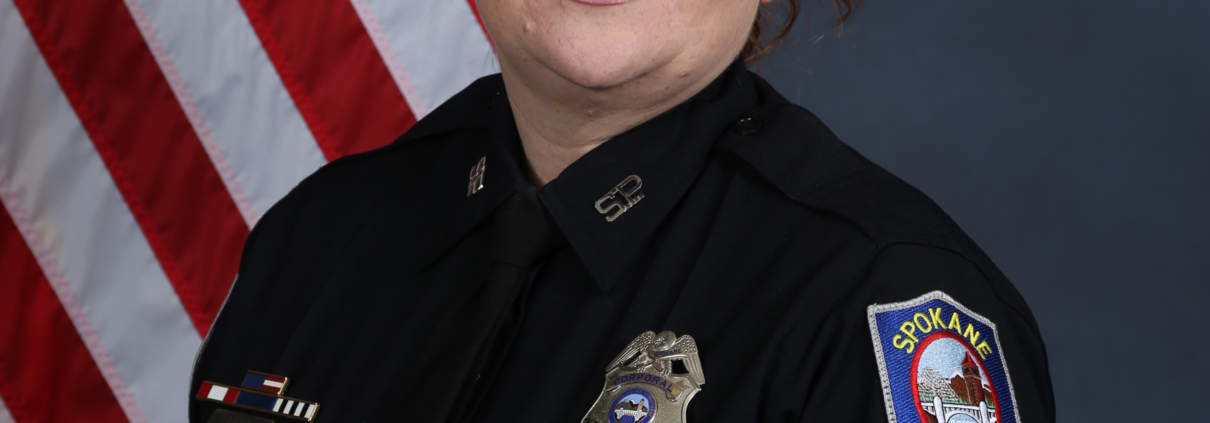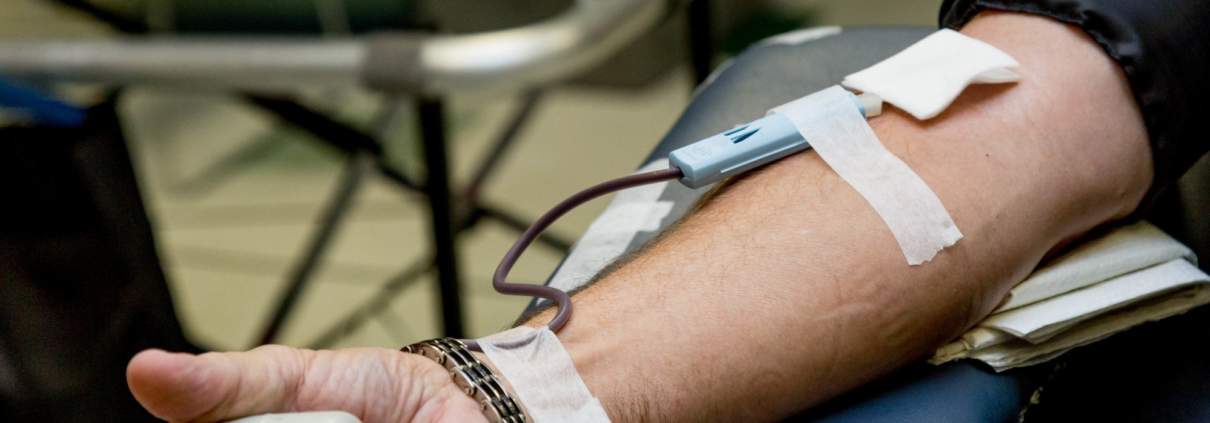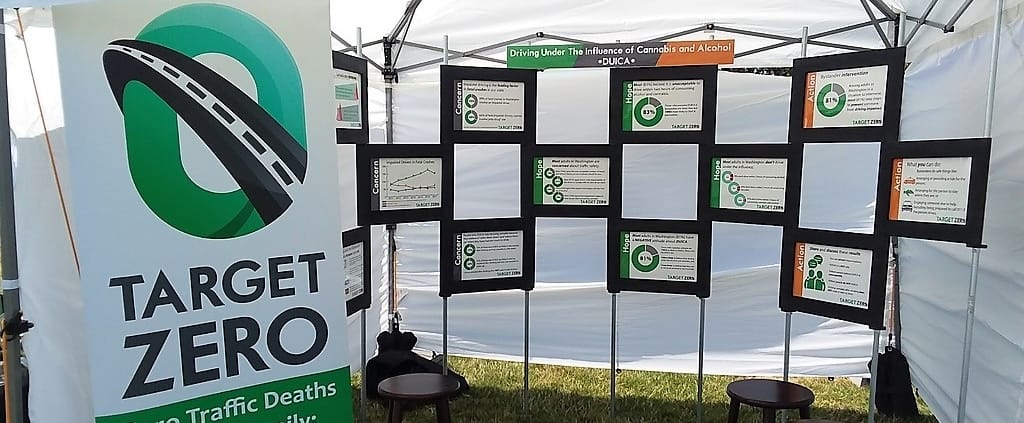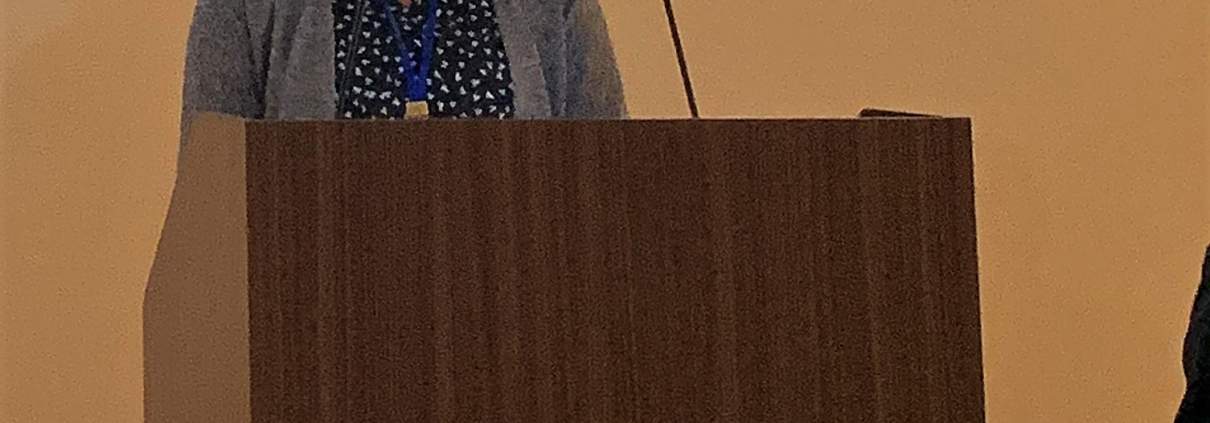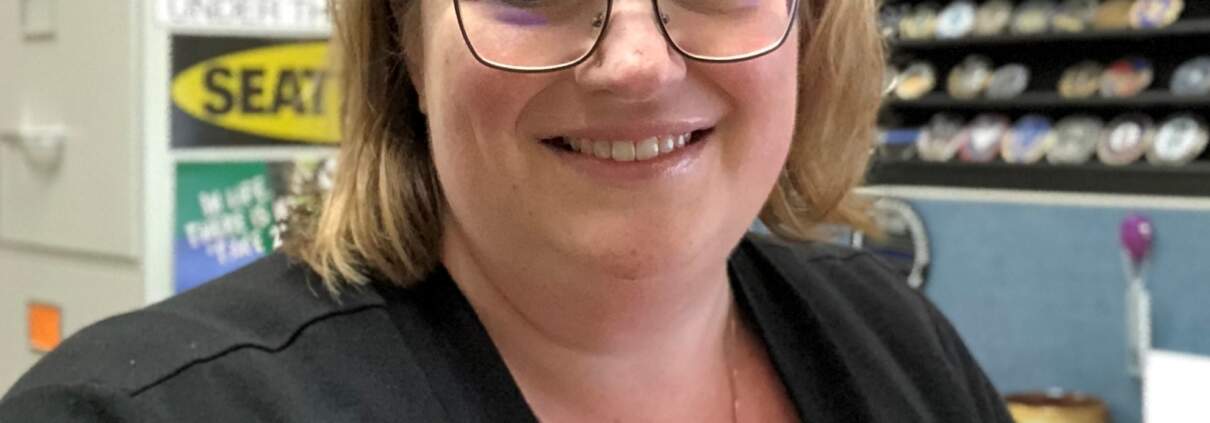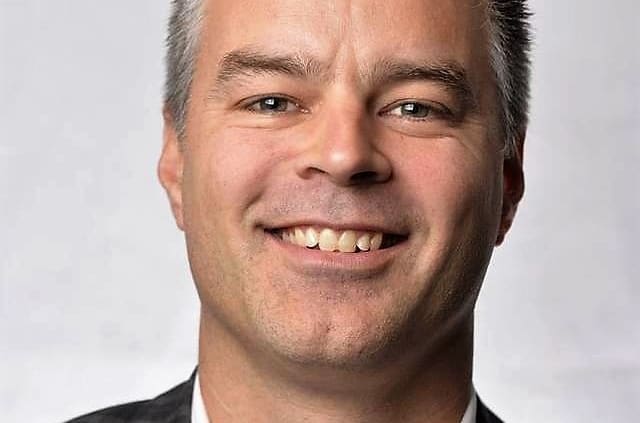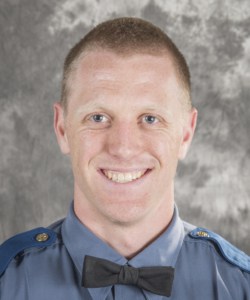
Michael Pry
Michael Pry first thought of going into law enforcement while he was a teenager. “My next-door neighbor, when I was growing up in Lacey, was a police officer, and took me on a ride-a-long.”
Something clicked, and today Pry is a trooper in the Washington State Patrol, based in Lewis County. Hooked on patrolling the roads as a teen, this past year he returned to his roots and turned his focus to helping teens be safer drivers. His efforts have been successful, leading to a decline in teen driver-involved collisions in Lewis County by 19 percent.
“I was on patrol one day after responding to several collisions involving teen drivers,” Pry recalls. “I wondered how we might focus on reducing collisions. I remembered back in high school the first place I drove was to and from school. So I thought if we can just work in school zones we might be able to identify problem teen driving behaviors, before they crash.”
Trooper Pry pitched the idea of adding focused patrols in school zones before and after school to his chain of command, who gave the go-ahead. With Lewis County stretching over 2,400 square miles and comprised of 11 school districts, Pry knew he couldn’t go it alone. He contacted county schools, and recruited city law enforcement agencies throughout the county, as well as the sheriff’s office, to participate. “We had four or five agencies all working together throughout the school year,” he says.
“We’d go to the school zones and patrol, looking for all the same violations we normally do, like speed, cell phones, seat belts. We’d pull them over and give them a written warning. And we’d give them a couple of days to take that home and show their parents, and make their parents call our office and say that they know their child was stopped, and say what they were going to do to correct the problem.”
The parents addressed their problem teen drivers in different ways. “A lot of them would take the keys only for a week. Or some had a long chat about safe driving. I know a couple of them called in to say their child got grounded.”
Pry emphasizes the program wasn’t about giving tickets or a fine – but to get the teens to go home and talk to their parents about their driving. “The students go home and say ‘hey, I got stopped. This is what happened.’ And then the parents figure out what they want to do or what they think is the right course of action. I figured it’s better to just let the parents parent.”
Pry said the most effective thing parents can do to instill safe driving habits in their teens is drive safely themselves. “Parents need to display the behaviors they want their kids to use. When teens see their parents driving faster than the speed limit, or not wearing their seatbelt, or using their phone, they pick up on that and do the same things. They’re watching. And they’re going to think that whatever you’re doing is ok.”
Pry also suggests parents ride with their kids after they get their license. “Every once in a while, you might want to ride with your teen and see what they’re doing.”
During the school year Pry estimates that officers made nearly 300 stops county-wide. During the school year in Lewis County, collisions decreased 19 percent over the previous year. Over the summertime, collisions dropped 10 percent. For the first time since 2014 collisions involving teen drivers dropped below 150.
“I think it definitely made a difference,” Pry says.
###
by Miriam Norman, Traffic Safety Resource Prosecutor

Miriam Norman
I started my career as a young bright-eyed, naïve child; I was 24 when I graduated law school well over a decade ago. In law school, all three years, I interned at the Harris County District Attorney’s Office (Houston, TX), and wow did I learn things. I am both proud and amazed that the first time I knowingly saw marijuana was as a prosecutor. Either I was obtuse or sheltered to the point, that through my formative years, I did not ever even see it (nonetheless touch it!) It is much to the amusement of friends and family that I am now an expert on drugs and impaired driving. Drugged driving was not so prevalent when I started my career, though.
When I started my career, we were fully focused on alcohol only DUI. Even as a Rule 9 intern (a law student with attorney oversight) in Texas, I handled several DUIs- all alcohol only. As a young prosecutor, it was rare that we saw DUI-drugs. I do remember seeing my first DUI-drugs case, and lucky for me, a Drug Recognition Evaluation (DRE) was conducted. DREs are the best evidence in a DUI-drugs case, but more on that in another article. Nowadays, almost half of all cases are DUI-drug cases. According to the most recent data from the Washington State Patrol Toxicology Lab, 36 percent of all blood has active THC (the psychoactive component of marijuana) in it, and 41% of all blood has Carboxy-THC (the inactive metabolite that means marijuana was used at some point) was present. That is nearly ½ of all blood.
As it pertains to alcohol, MADD, public policy, and societal norms have worked wonders in establishing that driving under the influence of alcohol is dangerous and wrong. DUI arrests for strictly alcohol are generally down across the country. This is not to say that our job is over! Thirty-eight percent (the majority) of all fatalities on our roadways are caused by an alcohol impaired driver. Our goal is zero deaths and disabling injuries from impaired drivers. Even with just alcohol only, we have a challenge before us.
Despite DUI-drug arrests increasing, Drug Recognition Evaluations have not similarly gone up in number. Unfortunately, evaluations have markedly decreased.
What we are seeing on our roadways is, that since 2008, 62 percent of all fatalities on Washington’s roadways are caused by drugged drivers. 44 percent of the 62 percent are poly-drugged drivers. Poly-drug means more than one impairing substance detected, e.g., the most common combination of poly-drugged driving is alcohol and THC. One quarter of all crashes in Washington have a poly-drugged driver involved. To say that drugged driving and poly-drugged driving is something we need to address is understating the magnitude of the issue.
Many ask what is going on? Truthfully, I do not know. I believe we have gotten better at detecting drug impaired driving. The Drug Evaluation and Classification program (DEC/DRE) was established in the 1970’s. The validation studies confirming the usefulness of the DRE program were conducted in the 80’s and early 90’s. Prior to that, officers may have been seeing odd behavior, but not able to quantify it or express it as impaired driving. We are quite good at detecting alcohol impairment, not so much for other drugs. All three studies did confirm that suspects arrested by the DREs would have gone undetected and arrested without the tools provided by the DRE program. The flip side of that argument is more people are using drugs. That is also accurate.
Drug users have more drugs available to them and will use all the drugs. Where one drug used to be their favorite, with the wide availability and accessibility of alcohol, marijuana, and a multitude of other drugs, they will use whatever they can. Anecdotally we are seeing more cases with a wide array of impairing substances in blood. This creates challenges for our officers to be able to articulate what they are seeing and why they are seeing it. More training is needed to give our officers more tools to tackle impaired driving.
Although this is may look like a bleak picture, the beauty is we have room to grow. Challenges can be overcome. We need all the stakeholders in the fight against impaired driving on board. We need to stop normalizing impaired driving of any sort. We need to talk to our friends and families and express that marijuana is not safe to drive under the influence of, and it is not acceptable either. We need to voice our concern and do our part. As Target Zero Managers (TZMs), you have a unique ability to assist in the fight. You have the ability to arrange drug impaired driving enforcement trainings. Huber and I are happy to come and train. We need your support and ability to get this training into the hands of the officers who need it most. Officers need to be trained on drugged and poly-drugged driving. They need more information on how marijuana affects the human body and what to look for to see if someone is safe to drive or not. As TZMs, we invite you to host us, encourage officers to attend, and facilitate a training with us. We are completely free to you and are happy to come! Please let us know how we can help you in your mission of Target Zero!
Feel free to reach out to me or have any officer reach out to me about any traffic, search warrant, impaired driving, courtroom, testimony, prosecution, investigation question!
Email: Miriam.norman@seattle.gov
 Did you know most traffic crashes are completely preventable? In the five-year period from 2013-2017, there were 2,551 people who died on Washington’s roads in traffic crashes. Nearly half of these fatal crashes (1,259 of 2,551) involved a driver impaired by drugs and/or alcohol. Washington has seen an increase in poly drugs – a combination of multiple drugs or drugs and alcohol in drivers. While alcohol can be detected through breath tests, blood draws and analysis is the best way to show courts the complete picture of a driver’s intoxication level.
Did you know most traffic crashes are completely preventable? In the five-year period from 2013-2017, there were 2,551 people who died on Washington’s roads in traffic crashes. Nearly half of these fatal crashes (1,259 of 2,551) involved a driver impaired by drugs and/or alcohol. Washington has seen an increase in poly drugs – a combination of multiple drugs or drugs and alcohol in drivers. While alcohol can be detected through breath tests, blood draws and analysis is the best way to show courts the complete picture of a driver’s intoxication level.
A Law Enforcement Phlebotomy Program is a national model that promotes public safety with a safe, secure means to collect blood for evidentiary purposes in impaired driving cases, with blood collection done pursuant to search warrant or consent. The goal is to reduce the number of drivers who refuse breath tests and increase the number of impaired driving convictions using blood evidence.
A phlebotomist is specifically trained and currently qualified to perform venipunctures. Safety during the course of a blood draw is paramount; it is the duty of each phlebotomist to follow department policy and procedures. This law enforcement phlebotomy project directly supports our state’s Target Zero efforts. Law enforcement phlebotomists allow officers to process more impaired drivers in less time. This time savings will allow officers to get out of the hospital waiting rooms and back on the roads to stop and process more DUIs. Ultimately this will make our roads safer.
Lakewood Police Department led the Law Enforcement Phlebotomy pilot project in Washington and has assisted other agencies in expanding the program. Currently, WTSC provides grant funding to support these projects with several agencies and officers in Pierce and Clark Counties. WTSC is in discussions to support this program in other areas around the state. Refusal rates have dropped in large part due to increased public awareness – the public is aware that if a suspect refuses to have their blood drawn when under arrest for DUI they will lose their drivers license for a period of one year, a zero tolerance approach by law enforcement, search warrants – judges are available 24 hours a day to process warrants in both misdemeanor and felony cases and whether or not the incident is an injury collision and better interagency cooperation.
More information can be found in NHTSA’s Law Enforcement Phlebotomy Toolkit.
Attendees of Bellingham’s first Budfest, billed as a celebration of “cannabis culture” in Whatcom County, probably didn’t expect to sit down and talk about marijuana and safe driving. But that’s exactly what many of them did with Region 11 Target Zero Manager Doug Dahl.
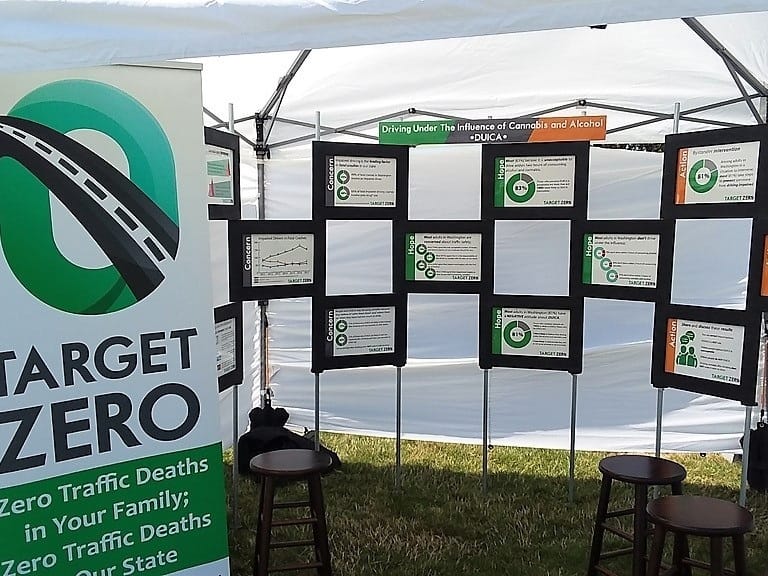
“I was really pleased with how many people engaged and wanted to have conversations about being a responsible cannabis user,” Doug says.
With a booth next to one for a bong shop, Doug displayed posters he made from the University of Montana’s research, commissioned by the Washington Traffic Safety Commission, about driving under the influence of cannabis and alcohol (DUI-CA). “I set the posters up in a semicircle and put stools in the middle so people could just come in and sit down and look it all the information.”
Doug was surprised at the positive response he got.
“I’ve done a good number of fairs, and I’ve always tried to have a game or something fun to engage people. So, I felt a little uncomfortable going into this with just information and only stools for people to sit down. There were no gimmicks. But it was an effective way to engage people in conversations because they actually want to talk.”
The information Doug presented struck a chord with Budfest attendees. “Overall they had a really positive attitude towards safety when it came to cannabis use and driving. They shared their own behaviors, saying ‘if I use cannabis, I just don’t drive that day,’ or however long it was a concern for them. Or they shared a story about a time they drove impaired or got a DUI and how it changed their behavior.”
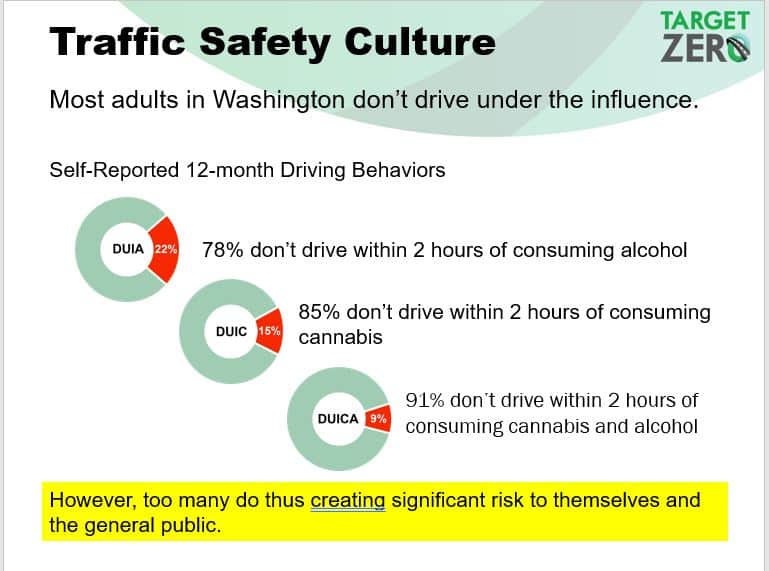
Doug found that sharing information through a framework of positive community norms was effective. “One of the models they use in positive community norms is balancing hope and concern. And so, I used some of the results from the University of Montana study talking about the risk factors of driving under the influence of cannabis and alcohol. And the hope was seeing such positive values from Washington drivers around not driving after consuming anything, and being willing to intervene, and trying to do something.”
Doug found that visitors to his booth responded positively, especially to the information around bystander interventions. According the University of Montana’s research, among adults in Washington who are in a situation with a DUI-CA impaired driver, most (81 percent) intervene.
“The research on bystanders seemed like it was really an encouraging thing for people. They told me how they feel they should intervene, and the idea that most people do intervene seemed to give them more confidence to act when needed.”
The organizers of Budfest supported the traffic safety message and, in fact, had invited Doug to attend and provided the booth space for free. “I regularly attend a community meeting that involves bar owners, cannabis stores, and law enforcement, and I met the organizers there. They want this kind of partnership, and recognize the need to promote safety, and for having responsible cannabis users.”
Not only was the desire for responsible cannabis use shared by festival attendees, Doug also found attending provided positive reinforcement for the role he can play in delivering Target Zero’s message.
“Sometimes when you’re in any field for a while and you immerse yourself in information, it all becomes obvious to you. And all this stuff that anyone who’s working for the Traffic Safety Commission knows by heart, is still new information for a lot of people in the community. And they want to know it. So, I think we have more to share than we sometimes think we do.”
###
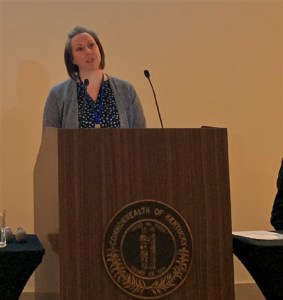
Alison Mitchell
Teen traffic safety is a driving passion for Alison Mitchell. Some of that passion springs from her role as Target Zero Manager (TZM) for Region 15 in rural eastern Washington.
But it’s personal, too. “I’m also the mom to two high school seniors who drive our rural roadways,” Alison says.
While traffic safety is a concern for most parents with teens, Alison decided to do more than worry. Already inspired by her husband’s career in law enforcement, she leapt at the chance to become a TZM when she learned about the job.
“I finally have the job that doesn’t feel like a job,” she says. “It’s what I live and breathe and wake up to do every morning and I’m really enjoying it.”
Alison focused on teen driving out of the starting gate, as her own kids were undergoing the driver’s education process.
One of the resources Alison found was Impact Teen Drivers, a non-profit awareness and education organization that provides educational materials, training and workshops related to changing the culture of teen driving.
“Impact Teen Drivers is clear, it’s effective,’ she says. “We’re using it in high schools, in middle schools, and private driver’s education courses. Everyone is loving it, including teenagers. It’s not fear-based. It’s very data-driven, positive, and empowers teenagers to make the right choices.”
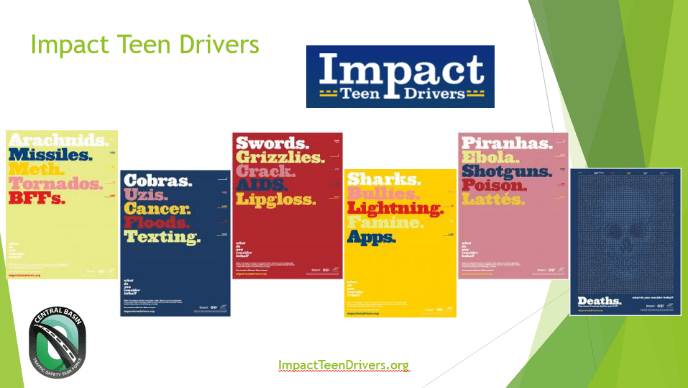
Alison reviewed her experiences using Impact Teen Drivers, and other tools focused on teen traffic safety, as a presenter at the 2019 Lifesavers Conference.
In January Alison was attending a workshop for the Impact Teen Driver program and met program founder Dr. Kelly Browning. Browning was intrigued by Alison’s experiences on the front lines, and invited Alison to present at 2019’s Lifesaver’s Conference in Louisville.
“Alison’s invitation to present at Lifesavers,” said Jerry Noviello, who coordinates the Target Zero Managers for the Washington Traffic Safety Commission, “is the result of her seeking new opportunities, tools and partnerships and using them in her region. It’s to her credit that she could highlight her work and Washington on a national platform.”
During her presentation, Alison shared her experiences with the Impact program but also provided perspective about the teens driving in rural areas.
“We live in the middle of nowhere,” Alison says. “It’s a great place to raise kids, but there are downsides. It’s 45 minutes to the nearest large grocery store, for example. We spend a lot of time driving, including the teens.” Using her own teens as examples, she pointed out that her son drives an average of 1,600 miles each month, three times the national average for males his age. Her daughter’s millage puts her 4.5 times the national average for her cohort.
“Add these distances to factors like distraction, seat belt usage, speed and impairment, it almost seems like an unfair multitude of factors for teen drivers in rural areas,” she told the conference.
Alison believes a hands-on approach can help parents have an ongoing conversation with their teens about these challenges. One of the tools she uses is the Life 360 App, which can be downloaded to a smartphone and monitors driving behaviors like speed, hard braking, rapid acceleration, and phone use while driving. More than just a monitor on the teens, the app allows everyone in the family see how each is driving.
“Anyone in our private group can see if someone was going a little faster, and so we can say, ‘hey, what happened?’ It’s really about making sure everyone in the family is on the same page and following the same rules.”
Alison also believes it’s important to get teens involved as their own advocates for traffic safety. She provides opportunities for teens to volunteer at community events, like farmer’s markets and county fairs. The volunteers help distribute educational materials, or run activities like demonstrating impairment goggles or raffles. “It gets them excited and learning,” Alison says. “They’re kind of quiet at first but then they start talking and saying things about buckling up, going the speed limit, or never driving distracted or impaired, and all the good messages that probably never came out of their mouths before.”
From technology to training, Alison is finding ways to promote traffic safety, but believes the secret ingredient comes from within.
‘I think being effective at what you do, especially in this field, is just really being passionate. Sometimes you can feel like what you’re doing isn’t making a difference. But one thing I took from Lifesavers was that what I’m doing really does matter.”
Her advice? “We just need to keep staying the course and keep staying passionate, learning, and sharing, as much as we can and with as many people as we can.
“I love being able to educate people, to reach out to teenagers especially, and be able to talk to different community groups and seek their support. I have the chance to bring traffic safety to life for a lot of people who don’t normally think about it.”
You can follow Alison’s work in Region 15 on Central Basin’s Traffic Safety Task Force Facebook Page.
###
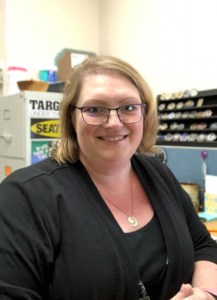
Stacy McShane
Stacey McShane was a 911 dispatcher for more than two decades when a DUI tragedy close to home spurred her involvement in traffic safety. Today she is Target Zero Manager in Region 10 – Snohomish County. Recently Stacey let us know about a grant program entering its second year in Snohomish County to help maintain DUI training.
Q: Agencies in your region cut back on training – can you tell us the background on why that happened?
A: Snohomish County was hit really hard during the recession when the housing market went upside down, which led to slashed local government budgets. For law enforcement that meant a lot of training went by the wayside. Many of our agencies, especially some of our bigger agencies, stopped renewing their blood alcohol machine certifications. And once that lapses they’re required to complete a 16-hour class to get it back. And that just makes the problem worse since it creates the need for more training and just makes a bigger budgetary hole.
Q: What was the impact on traffic safety?
A: There were fewer officers certified to do sobriety testing, fewer arrests and fewer court filings. The data show a huge drop in DUI arrests in our county over a five-year period.
The other issue is the time it takes to process a DUI arrest. Five-to-ten years ago it took about an hour, today it can average three-to-five hours. So, when you have a patrol officer at an agency with minimal staffing now taken off the road for several hours, it really impacts the agency because they can’t process the 911 calls that are coming in.
Q: How did you solve this problem?
A: We secured a grant to cover the BAC training – both the full 16-hour training for those who needed it and renewal training for those who hadn’t had their certification expire. That took a big burden off of our agencies.
Q: Was it just BAC training covered in the grant?
A: No, we included Standard Field Sobriety Test training, Advanced Roadside Impaired Driving Enforcement (ARIDE) and Drug Recognition Expert (DRE) training. For next year we’ve added training from a traffic resource prosecutor.
Q: You are coming close to the end of your first year, has the program been successful?
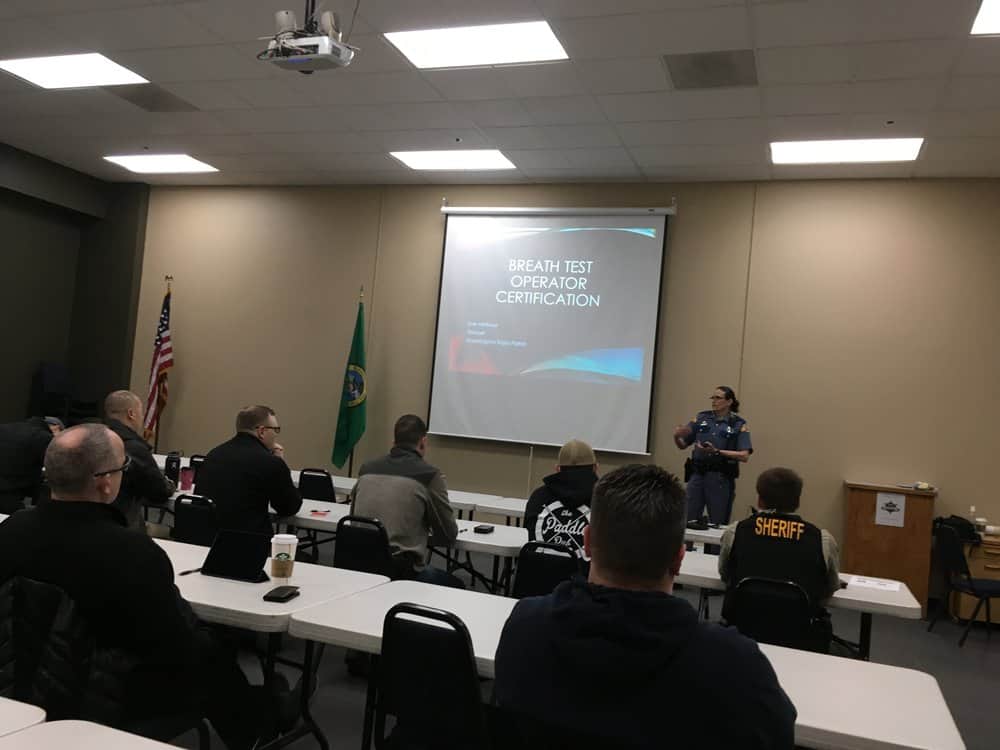
BAC class is in session!
A: We had 15 people go through the ARIDE class. We put 28 people through the basic BAC class. Not all of those officers were on overtime on the grant. Agencies really stepped up where they could to send officers on duty. The refresher training is offered on and off throughout the year. It’s been a tremendous relief of the burden on the local agencies. Our current grant is for $50,000. The entire sheriff’s office training budget here is $90,000. So, to even bring in $10,000 to $15,000 to the sheriff’s office for training is a big help.
Q: What about the time requirement you mentioned for a DUI arrest. How does the training grant help with that issue?
A: Our hope is that by getting these officers certified and running more DUI’s they will get more efficient at it, within legal constraints. We also think it will address some of the concerns we heard from the prosecutor’s office about the quality of filings, which we think will improve as officers gain more experience.
Q: If another region wanted to implement a similar grant, what advice would you give them?
A: Prepare for a lengthy planning process. We had to establish memorandums of understanding (MOU) with the cities and get that through legal. Each MOU had to go through the individual city councils and that took time on their end. It took almost an entire quarter to get that straightened out. Now we have a template as we go into our second year, so it’s just a matter of updating some of the legal language.
You also want to make sure you write some extra time into the funding to cover the Target Zero Manager’s time, because it generates more work to develop and then maintain a tracking process.
Q: How did you get involved with traffic safety?
A: My husband’s cousin was killed by a drunk driver just a few days before his high school graduation. At that time I got involved with MADD. I was doing volunteer work with them when this position opened up. I decided it was time to change careers and do something I had become passionate about. Once you stand at the grave of a 17-year-old kid on the day he’s supposed to have his graduation party, it’s pretty impactful.
Have a success story you want to share? Contact Erica Stineman at estineman@wtsc.wa.gov

exc-5b7f0b8c40ec9a251b1afec0
Gloria Mansfield Averill had a background in child welfare and nonprofit leadership before taking on traffic safety as Target Zero Manager (TZM) in Region Five (Pierce County). We sat down with Gloria to discuss Region Five’s program to certify law enforcement officers in phlebotomy to facilitate timely blood draws from suspected drug-impaired drivers.
Q: Tell us about the traffic safety problem are you trying to address?
A: Impairment from multiple drug use is the most common type of impairment among Washington drivers now. There are many drivers today who die in crashes with more than one drug in their system compared to not many years ago when impaired collisions involved primarily alcohol. When we began to see in the last few years that drugged driving deaths and injuries were eclipsing those involving only alcohol, we needed an approach to help us better identify the presence of drugs in the blood of drivers.
Q: How does that switch impact enforcement?
A: Until the beginning of our project in the city of Lakewood two years ago and our expansion of the project throughout the County last year, officers had to take their arrestee to a hospital or clinic to draw blood. Then those medical facilities began adopting policies that required arrestees to be checked in along with all the rest of the waiting patients. In some cases, policies were developed to charge for the blood draw. The bottom line was that the process was going to take more time and money than law enforcement agencies in Pierce County could afford.
Q: And there’s importance in getting the blood drawn quickly, isn’t there?
A: Yes. For example, with marijuana you need to get the blood drawn within an hour or the first 90 minutes before the impairing part of the drug starts dissipating. So, the closer you do the blood draw to the observed impaired driving the better.
Q: With increasing numbers of multidrug, or polydrug impaired drivers and increasing difficulty in getting timely blood draws, what did you do?
A: We developed a program to train officers to do the blood draws themselves. One of the officers in Lakewood who often does DUI patrols with the task force heard about this approach and was enthusiastic about trying it here. We worked together, and I did some research, made some phone calls and I wrote a grant on behalf of the Lakewood Police Department to the Traffic Safety Commission to set up the first law enforcement phlebotomy project in Washington. It was enthusiastically funded!
Q: So how do the blood draws happen under the program?
A: Law enforcement set up a room at the station much like a room in a hospital, with a special chair for blood draws, equipped with draw supplies, and a camera, because everything is recorded. An officer who has been trained in the same way as all certified phlebotomists in the state of Washington does the actual draw.
But it doesn’t have to be in the station. During the state fair the Puyallup City Library opened their doors and let the trained officer phlebotomists bring a portable unit they developed that could be brought to special task force emphasis patrols or events.
Q: What kind of training is involved for the officer?
A: They go to a local technical college and take a course that meets State of Washington Medical Assistant-Phlebotomist Licensing requirements. This lasts several months, with classes only several times a week. But officers are actually required to do additional practice draws, than are required by the training program for all other students. We go the extra mile so no one can come back and question the program.
Q: What is the status of the program now?
A: We started as a pilot in Lakewood, and from there expanded out into Pierce County. Three phlebotomy sites in the County have already been established. Three more are in the works, including possibly the Puyallup jail, the Gig Harbor Police Department and the Tacoma Police Department. The Tacoma Police Department is coming on board with five of their officers training this fall. So far, we have 20 trained phlebotomists, but anticipate more in the coming year.
Having the program region wide, not just city by city, is what will really make it work. It’s an on-call 24/7 system, and so by going region-wide we have enough phlebotomists available to the WSP and all Pierce County allied agencies.
Q: What does the grant cover?
A: It covers the equipment, like the blood draw chair, the supplies, camera, as well as tuition and class materials and overtime for officers to take time from their regular duties to attend the phlebotomy classes and prepare for the final exam for certification.
Q: Earlier you spoke of the trend towards impairment from polydrug use. You recently dedicated one of your DUI enforcement patrols to a victim.
A: It’s a really sad case. The mother of a three-year old, Brody Debenning, was high on three different drugs and she crashed head-on into a truck, with Brody in the car. And there had never been any other family members in his life other than his impaired mom. Brody was actually placed in foster care for a time, and I helped find the two foster moms who took him in while his mom was trying to get clean. But it wasn’t long after Brody’s biological mom regained custody that the crash occurred.
[Read KIRO-TV news story for more about Brody and the enforcement dedication]
Q: Tragic cases like that really underscore the need for raising awareness about polydrug impairment, and the need for enforcement tools like the one you’ve created in Pierce County.
A: Yes. I’ve found traffic safety extremely seductive. There are real opportunities if you are creative and willing to try new things, like this phlebotomy program. It’s really worthwhile. Hopefully, we will eventually see the impact of the approach as we gather the data. No one should have to die at the hands of an impaired driver.
Have a success story you want to share? Contact Erica Stineman at estineman@wtsc.wa.gov
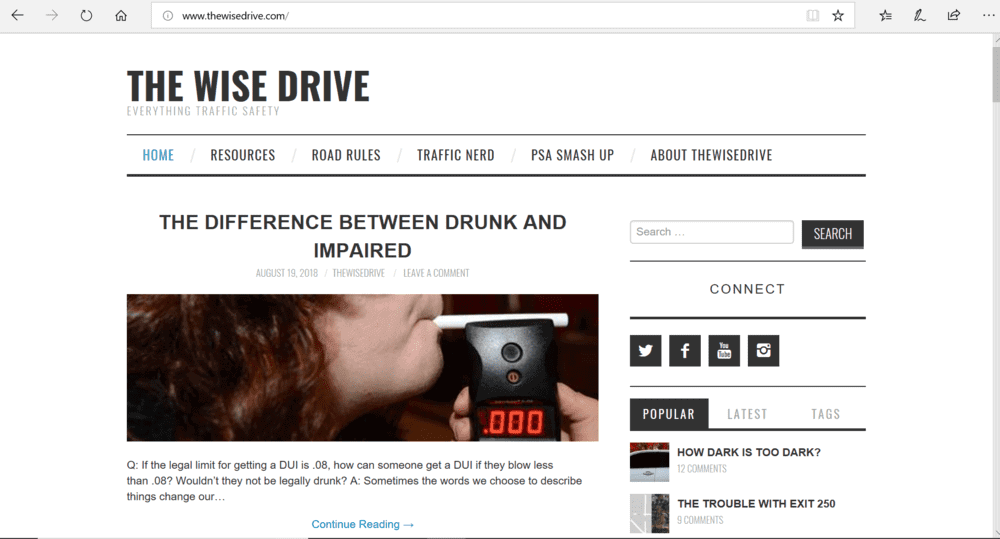
Doug Dahl’s traffic safety blog, “The Wise Drive”

Doug Dahl is former deputy for the Whatcom County Sherriff’s office and is currently on his second stint as Target Zero Manager (TZM) in Region 11. He is author of a weekly column in the Bellingham Herald, “Rules of the Road,” and a blog, “The Wise Drive.” We sat down with Doug to get a sense of how we started his column and blog and his thoughts on how it fits in with traffic safety education.
Q: Tell us about how you got your start with the blog and writing a weekly column?
A: I had developed a website for our region the first time I was a Target Zero Manager (TZM). I wrote an article and took it to the Bellingham Herald and asked them if it was something they’d be interested in. And it became a weekly column.
Q: How do you see the column/blog fitting in with your role as a TZM?
A: There’s almost two halves of my job. One half is working with local law enforcement agencies and coordinating HVE patrols. The other piece of it is the education part. The column and blog give me a platform for traffic safety outreach.
Q: What do you see as some of the challenges in getting our messages out?
A: I’m surprised at how often I encounter people that are bright people but don’t have an awareness of some of the risks of driving and how some simple changes to their behavior can have such a huge impact on their exposure to traffic risks.
Q: What’s the most difficult question you’ve had to answer?
A: I don’t know what is the most difficult but I can tell you the least liked answers are the ones advocating for more speeding enforcement.
Q: Your articles are based on questions that readers send in. Was it difficult to get readers to send questions?
A: No. I get more questions than I can answer. Right now, I have 16 pages of unanswered questions. Some questions are redundant or have been addressed before, so I might just send a person a link to something that’s already been answered. But I don’t have a shortage of questions.
Q: Do you have a method for deciding what questions to answer?
A: I might save a question to coincide with something that’s happening. If we know we have a DUI patrol coming up I might hold off on answering a question about impaired driving until it corresponds with the emphasis patrols.
Q: How much time do you spend on the column per week?
A: Depending on how much research I need to do for the article I would say around four hours per week.
Q: Do you do a lot of research?
A: I spend time looking up information in the RCW, and there are a lot of complexities there, so I feel a real responsibility to get it right. I have resources or experts in the traffic safety community, law enforcement, and with traffic engineers, so I can contact some of those folks and tap into their expertise.
Q: You recently published a story about autonomous cars that featured a video of you riding along. How did that come about?
A: It was a semi-autonomous Tesla and was spur of the moment. There was a Tesla at the Traffic Safety Conference and they were giving rides so I made a little video. I keep a little Panasonic micro camera with me, as it’s better to capture something and tell a story. And I thought that was an important story to tell. Autonomous is the direction things are going and we need to be having conversations about what that’s going to look like for traffic safety, and how we’re going to integrate technology into the way we drive.
Q: Are the Herald columns and the content on the blog the same?
A: Mostly the same. But on the blog I sometimes write something nerdier about traffic data. Or I will sometimes highlight traffic safety PSAs, sometimes because they’re really good and sometimes because they’re really terrible.
Q: Do you have a sense for how many people read your blog or column?
A: My website traffic ranges from between 20 or so people to 600 on a good day. The Herald tells me they estimate a few thousand people read it each week. When I started out all my questions came from folks in Whatcom County and now I get questions from people spread out all over the state.
Q: What has it been like working with the Herald?
A: Well, they get their article for free and they like that! But they’re great to work with – they don’t really edit anything I do and give me a lot of latitude to answer whatever I want. So, I think the partnership there works very well.
Q: Is that something you think can be replicated?
A: I think we can find more places where we can have those kinds of partnerships because people are constantly talking about driving. Everyone has a story about getting pulled over or some crappy driving situation they were in, or something they saw. So, it’s a real accessible topic.
Q: In terms of managing your blog, is the technology difficult?
A: Well, my first foray into websites and blogging was back in the 90s and I had to learn HTML, so compared to that today is super easy! Today you basically use templates where so much is already done for you.
Q: What advice or tips would you give to someone else wanting to start a column and/or blog?
A: Try your very best to get a local newspaper to print it in addition to having a blog, because that forces you to have a deadline and it makes you consistent. I think the most important thing you can do is have consistent and regular content. A newspaper column forces you to meet a weekly deadline.
But I think the best thing to do is to do whatever you can get excited about because not everyone’s going to be excited about writing an article. If it’s something you can get excited about you’re going to do it a lot more often than if you feel like it’s a chore. And there are so many different ways to do traffic safety education.
Have a success story you want to share? Contact Erica Stineman at estineman@wtsc.wa.gov


